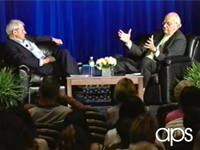A Learning Machine: Plasticity and Change Throughout Life
Drawing together five psychological scientists unlikely to cross paths outside of a conference, one of the APS 18th Annual Convention’s themed programs, “Plasticity & Change: A Lifelong Perspective,” showcased extraordinary research from various areas, all suggesting that the brain is almost infinitely adaptable from earliest infancy through latest adulthood Although their research approached the topic from different angles, each presenter demonstrated the brain’s extraordinary capacity to bend, stretch, expand, and specialize itself in response to challenges.
Gregg Recanzone, University of California, Davis, kicked off the discussion with a talk on animal models of adult neural plasticity. His findings indicate that the brain can be trained to increase its sensitivity to various stimuli. In one experiment, Recanzone exposed adult owl monkeys to two tones and decreasing the difference between them over time. After several weeks of training at this relatively simple task, their auditory sensitivity sharpened to a point at which they were able to easily discriminate between tones that were indistinguishable at the beginning of training. This increased sensitivity, Recanzone found, corresponded with a functional reorganization of the cerebral cortex — meaning that the activity of large populations of neurons in the monkeys’ brains adapted. This evidence of plasticity in animal subjects’ brains, Recanzone said, suggests that long-term levels of performance may be related to changes in neural activity.
Purposes of Plasticity
As a “learning machine,” said the next presenter, Michael Merzenich of the University of California at San Francisco, the brain “has the incredible task …of recapitulating what we’ve learned in the history of our species.” Merzenich has recently been researching plasticity among the elderly. Adult brains, he said, use plasticity for “purposeful” reasons, based on specific needs. For example, a professional musician might find it useful to train her brain to recognize absolute pitches, while a mechanic’s brain would be better served by expanding its sensitivity to the precise differences among types of rumbles from a troubled car’s insides. In contrast, during the “critical period” of childhood, the brain experiences “anything-goes plasticity,” adapting itself to sort and interpret a huge variety of incoming data from the world. As individuals master major skill sets, massive cortical changes occur, said Merzenich. It is only after the development of selective attention control — the ability to sort and focus on preferred input — that plasticity shifts into a more purpose-driven, adult mode.
Like the adult monkeys’ brain in Recanzone’s experiment, the adult human brain can be trained to accommodate new skills. Merzenich said that his research is about “shaping the machinery of your brain…to develop the capacities of your life.” As people grow older, he said, their brains become “noisier” because they are filled with more information, the management of which causes them to slow down. Increased noise degrades brains’ learning-control machinery. But these changes are reversible, Merzenich said. In one experiment, he used adaptive computer games to rejuvenate the learning machinery of elderly subjects. His findings are striking: Through auditory training, people between the ages of 70 and 95 were able to recover the cortical plasticity of people 10 to 15 years younger than they. Visual training resulted in increased plasticity equivalent to that of brains 25 years younger. Countering conventional wisdom, which says that brains simply slow down with age, Merzenich said that it is “very easy to change cortical dynamics by training.”
The Logic of Imagination
Merzenich focused on the elderly; Alison Gopnik of the University of California, Berkeley talked about plasticity in children’s brains. In “The Logic of Imagination: How Children Change the World,” she offered insight on the potential connection between children’s imaginative capacity and the patterns of human evolution. “Everything in the environment we live in now was completely imaginary at one point in time,” she said. “The deepest part of our human nature is that we are trying to escape human nature.”
Evolution, Gopnik said, requires that we discover new things about how the world works and use this knowledge to imagine new things, to change the world based on our imaginings. Cognitive stretches are made possible by the brain’s ability to create abstract representations of the world, imagine things that don’t exist yet in those representations, and build them. Our ability to develop coherent theories about how things work — or might work — is what allows us to turn imagined worlds into real ones. Gopnik proposed that young children behave like scientists exploring the world for the first time: making predictions, testing them, comparing data, and forming new theories. She discussed an experiment in which young subjects were encouraged to hypothesize about the nature of an object that seemed to respond to both physical stimuli and vocal requests. Based on their knowledge of the world, the children all assumed initially that the object could not respond to their vocal commands. When it appeared to do just that, the children were able to override their assumptions and theorize that the object did in fact understand them. “Children do seem to begin with assumptions about how the world works, but can very rapidly use data to learn,” Gopnik said. “Children are able to use this powerful computational machinery to imagine new things in the world, and they can use that new information to do new things in the world…. What children are doing is discovering new things about the world, and later on using that machinery to change the world.” Like little scientists — and like every human who has ever imagined and invented anything new — children hypothesize, experiment, and make changes based on new data. Their ability to reshape their assumptions according to reality and then reshape reality based on their imaginings reflects the course of human evolution as a whole. It is the capacity for plasticity that makes it possible for children to learn and for the species to evolve, build, change, and grow.
Controlling Desires
In “Delay of Gratification Over Time: Mechanisms and Developmental Implications,” Columbia University’s Walter Mischel discussed another outcome of imaginative ability. With temptations of every kind constantly surrounding us, he asked, how do we learn to delay gratification? He proposed that the brain can conceive of two representations of every object – a “cool” representation of its abstract aspects and a “hot” representation of its rewarding traits. Anticipatory responses, such as salivation at the thought of delicious food, are “hot.” Delayed gratification, said Mischel, an APS Fellow, is possible because we can also conceive of that same food in abstract terms — as fattening, for example, or likely to give us a stomachache.
From birth, children want instant gratification. But by stretching their brains to encompass abstract concepts and counterfactuals, they are able to train themselves to control their desires. “What’s important is what kids are doing in their heads,” Mischel explained. He described an experiment in which children were shown a real cake and a picture of a cake. When he told the children to imagine that the real cake was only a picture, they reported “cool” reactions and a decreased desire to eat the dessert. When the children were asked to imagine that the picture was a real cake, they had “hot” reactions even though they knew the cake wasn’t really there. The degree of a child’s power to delay gratification at an early age is a good predictor of later coping ability. Early delay skills protect against later vulnerability, Mischel said, so training children in “cooling strategies,” like using their imaginations, can have a significant payoff later in life. “Delay makes it possible for people to cool it if and when they want to,” Mischel said.
Effects of Deprivation
The symposium’s final presenter, Sir Michael Rutter of King’s College, underscored the limits of cortical plasticity with a somber report on “Long-Term Effects of Early Institutional Deprivation: Findings From an Adoption Study and Implications of Causal Mechanisms.” Rutter and his associates followed the behavioral development of children who were adopted from Romanian orphanages by UK families after the fall of the Ceausescu regime. After evaluating them at the time of adoption, they studied a sample of such children at ages four, six, and eleven years, deploying a battery of cognitive and psychological tests to construct a theory about the results of profound deprivation followed by above-average living environments.
Some of their findings surprised them. “Like much of science, one has a mix of the expected and the totally unexpected,” Rutter said. At arrival, most of the children tested as mentally retarded, but by age eleven, they were nearly normal. Variations tended to correlate to the amount of time spent in deprived conditions: Children who had been in orphanages for less than six months recovered most completely, while those who were there longer displayed more severe and longer-lasting deficits. What surprised researchers was that the nature of the deficits varied among the children: Instead of consistently suffering a similar set of problems, each child showed a different pattern of disturbance. This finding suggested to Rutter that plasticity must vary from child to child — that individual brains will respond to similar extreme circumstances in completely different ways. Unable to find a strong connection between adaptive ability and the characteristics of the households that adopted the children, Rutter concluded that, although psychosocial deprivation was the main risk factor for all the deficits the children displayed, its effects are neither universal nor fixed — a challenge to what some developmental theories would predict most researchers would expect. “Whatever theoretical explanation we end up with,” Rutter concluded, “we’ll have to account for these huge individual differences.” Rutter also delivered the Keynote Address at the APS annual meeting.
The five presenters were delighted at the similarities they saw among their diverse fields. “We should change the way we do business,” said Mischel. “Psychological science is at the point that it should become a big science. We should think about the way that chemistry and physics became great sciences. The time of each person in his own lab should maybe be over.”




APS regularly opens certain online articles for discussion on our website. Effective February 2021, you must be a logged-in APS member to post comments. By posting a comment, you agree to our Community Guidelines and the display of your profile information, including your name and affiliation. Any opinions, findings, conclusions, or recommendations present in article comments are those of the writers and do not necessarily reflect the views of APS or the article’s author. For more information, please see our Community Guidelines.
Please login with your APS account to comment.